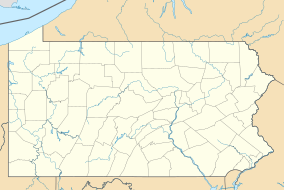Swatara State Park
| Swatara State Park | |
|---|---|
 The Appalachian Trail crosses Swatara Creek on the historic Waterville Bridge in the park | |
| Location | Pennsylvania, United States |
| Coordinates | 40°29′50″N 76°31′59″W / 40.49722°N 76.53306°W |
| Area | 3,515 acres (14.22 km2) |
| Elevation | 502 ft (153 m)[1] |
| Established | 1987 |
| Governing body | Pennsylvania Department of Conservation and Natural Resources |
| Website | Swatara State Park |
Swatara State Park is a 3,515-acre (1,422 ha)
Swatara State Park is a fairly new park for the Commonwealth of Pennsylvania. It was opened in 1987 and is still largely undeveloped. The Pennsylvania Department of Conservation and Natural Resources is working on plans to further develop the lands of Swatara State Park. The original plans called for the building of a dam and reservoir for recreational fishing and boating as well as to provide drinking water for the City of Lebanon. The PADCNR explored plans for developing the park without the recreational lake/reservoir,[2] and in 2012 started developing the park with infrastructure improvements to increase access to the biking, hiking, canoeing, fishing and picnicking opportunities in the park. Improvements include installing 10 miles of crushed stone along the rail-trail and work on abandoned Old State Road.[3]
History
Susquehannock Indians
The early history of Swatara State Park is tied to the Susquehannock people, Native Americans that once inhabited the ridge and valley region of Pennsylvania. This region of Pennsylvania is very mountainous, with the mountains located in close proximity to each other with narrow valleys between. Swatara Creek is in one of these valleys. The Susquehannock used it as a transportation route.[4]
Coal and Canals
This region of Pennsylvania was first settled by
Railroads to Bike Trails
Swatara State Park's
Recreation
Fishing
The waters of Swatara Creek were heavily polluted by runoff from the coal mines and sewage from the nearby municipalities. Over the years the water quality has gradually improved and there are now some fish living in the waters of Swatara Creek. Smallmouth bass and panfish can be caught in Swatara Creek. Irving's Pond is the home to largemouth bass and some panfish. Cold water species of fish such as rainbow trout and brown trout can be caught in Trout Run and other tributaries of Swatara Creek.[4]
Hunting
Hunting is permitted in most of Swatara State Park. Hunters are expected to follow the rules and regulations of the Pennsylvania State Game Commission. The most common game species are
Boating
Boating in Swatara State Park is limited to
Hiking

The
Natural history
Forests are overtaking the land formerly used by farmers, miners, canalmen and railroadmen. Woodlands are plentiful at Swatara State Park. Visitors can observe the slow process in which nature reclaims the land previously used by man. Fossil hunters can find ancient marine fossils at a site along Old State Route 443.[4]
Bordner Cabin
A log cabin, built in 1939 by local industrial-arts teacher Armar Bordner (1904-1994) and members of his class using materials found on-site next to the picturesque Acrigg's Falls, is preserved within the park. Bordner opposed the taking of his home by eminent domain by the old DER during creation of the park and was allowed to remain at the cabin for the remainder of his life, paying a token rent to DCNR each year. The cabin was then leased to the Boy Scouts of America for several years, and then was returned to DCNR control. After a proposal to raze the historic building, Swatara Watershed Association, led by Jo Ellen Litz, a Lebanon County commissioner, took over control of the building, which has been preserved by them including the installation of new roofing materials, but the cabin no longer has utilities or windows.
Nearby state parks
The following state parks are within 30 miles (48 km) of Swatara State Park:[5][6][7][8]
- Boyd Big Tree Preserve Conservation Area (Dauphin County)
- Joseph E. Ibberson Conservation Area (Dauphin County)
- Locust Lake State Park (Schuylkill County)
- Memorial Lake State Park (Lebanon County)
- Nolde Forest Environmental Education Center (Berks County)
- Shikellamy State Park (Northumberland and Union Counties)
- Tuscarora State Park (Schuylkill County)
References
- ^ "Swatara State Park". Geographic Names Information System. United States Geological Survey. August 30, 1990. Retrieved December 16, 2007.
- ^ "Swatara State Park Planning Underway". Pennsylvania Department of Conservation and Natural Resources. Archived from the original on February 15, 2004. Retrieved October 20, 2006.
- ^ "Swatara State Park Targeted for Trail Installation, Other Improvements" (PDF). Pennsylvania Department of Conservation and Natural Resources. Archived from the original (PDF) on August 31, 2015. Retrieved August 27, 2012.
- ^ a b c d e f g h "Swatara State Park". Pennsylvania Department of Conservation and Natural Resources. Archived from the original on November 2, 2011. Retrieved November 20, 2011.
- ^ 2007 General Highway Map Lebanon County Pennsylvania (PDF) (Map). 1:65,000. Pennsylvania Department of Transportation, Bureau of Planning and Research, Geographic Information Division. Retrieved July 27, 2007.[permanent dead link] (Note: shows Swatara State Park)
- ^ 2007 General Highway Map Schuylkill County Pennsylvania (PDF) (Map). 1:65,000. Pennsylvania Department of Transportation, Bureau of Planning and Research, Geographic Information Division. Retrieved July 27, 2007.[permanent dead link] (Note: shows Swatara State Park)
- ^ Michels, Chris (1997). "Latitude/Longitude Distance Calculation". Northern Arizona University. Retrieved April 23, 2008.
- ^ "Find a Park by Region (interactive map)". Pennsylvania Department of Conservation and Natural Resources. Archived from the original on September 24, 2011. Retrieved November 18, 2011.
External links
- "Swatara State Park official map" (PDF). (1.2 MB)


